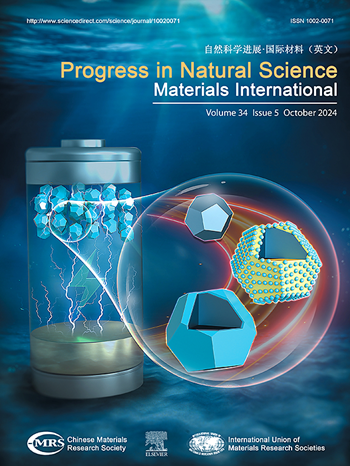热轧工艺制造高强度双金属型钢
IF 7.1
2区 材料科学
Q2 MATERIALS SCIENCE, MULTIDISCIPLINARY
Progress in Natural Science: Materials International
Pub Date : 2024-12-01
DOI:10.1016/j.pnsc.2024.10.003
引用次数: 0
摘要
本研究旨在研制一种满足塑性和强度标准的316L/35#不锈钢-双金属型钢。不锈钢双金属部分由316L不锈钢制成,母材由35#碳钢制成,采用界面真空技术在1150℃下用13台轧机轧制。此外,还对热轧不锈钢-双金属型钢复合界面的力学性能和显微组织进行了多尺度分析。选取成品、轧制截面型钢作为研究对象。利用透射电子显微镜(TEM)、电子探针显微分析(EPMA)和扫描电子显微镜(SEM)等多种技术对材料的力学性能进行了测试。结果表明,由于元素的扩散作用,复合界面两侧形成了明显的渗碳区和脱碳区。渗碳区宽度为30 ~ 50 μm,硬度为184.3HV;脱碳区宽度为80 ~ 100 μm,硬度为146.4HV。在渗碳区,观察到短棒状马氏体、第二相沉淀、碳化铬和氧化物。不锈钢包层型钢的抗剪强度为384.62 MPa,极限强度为599.76 MPa,远远超过了标准要求的210 MPa,表明双金属实现了良好的冶金结合。本研究为开展双金属材料结构完整性评价提供了重要的理论依据。本文章由计算机程序翻译,如有差异,请以英文原文为准。
Manufacturing of high strength bimetallic section steel with hot-rolling process
This study aimed to develop a 316L/35# stainless steel–bimetallic section steel to satisfy plasticity and strength standards. The stainless steel bimetallic section was made of 316L stainless steel, whereas the base metal was made of 35# carbon steel, rolled using 13 rolling mills at 1150 °C by applying interface vacuum technology. Moreover, the mechanical properties and microstructure of the composite interface of hot-rolled stainless steel–bimetallic section steel were analyzed at multiple scales. The finished, rolled-section steel was selected as the research object. Various experiments were conducted from multiple scales: transmission electron microscopy (TEM), electron probe micro-analyses (EPMA), and scanning electron microscopy (SEM) were utilized, among other techniques for testing the mechanical properties. The results revealed that distinct carburized and decarburized zones were formed on both sides of the composite interface due to the diffusion of elements. The width of the carburized zone was 30–50 μm, and the hardness was 184.3HV, whereas the width of the decarburized zone was 80–100 μm, and the hardness was 146.4HV. In the carburized zone, short, rod-like martensite, second-phase precipitates, and chromium carbide and oxides were observed. The shear strength of the stainless clad section steel was 384.62 MPa and the ultimate strength was 599.76 MPa, far exceeding the 210 MPa required in the standard, which revealed that the bimetal achieved good metallurgical bonding. This study serves as an important theoretical basis for conducting structural integrity evaluations of bimetallic materials.
求助全文
通过发布文献求助,成功后即可免费获取论文全文。
去求助
来源期刊
CiteScore
8.60
自引率
2.10%
发文量
2812
审稿时长
49 days
期刊介绍:
Progress in Natural Science: Materials International provides scientists and engineers throughout the world with a central vehicle for the exchange and dissemination of basic theoretical studies and applied research of advanced materials. The emphasis is placed on original research, both analytical and experimental, which is of permanent interest to engineers and scientists, covering all aspects of new materials and technologies, such as, energy and environmental materials; advanced structural materials; advanced transportation materials, functional and electronic materials; nano-scale and amorphous materials; health and biological materials; materials modeling and simulation; materials characterization; and so on. The latest research achievements and innovative papers in basic theoretical studies and applied research of material science will be carefully selected and promptly reported. Thus, the aim of this Journal is to serve the global materials science and technology community with the latest research findings.
As a service to readers, an international bibliography of recent publications in advanced materials is published bimonthly.

 求助内容:
求助内容: 应助结果提醒方式:
应助结果提醒方式:


